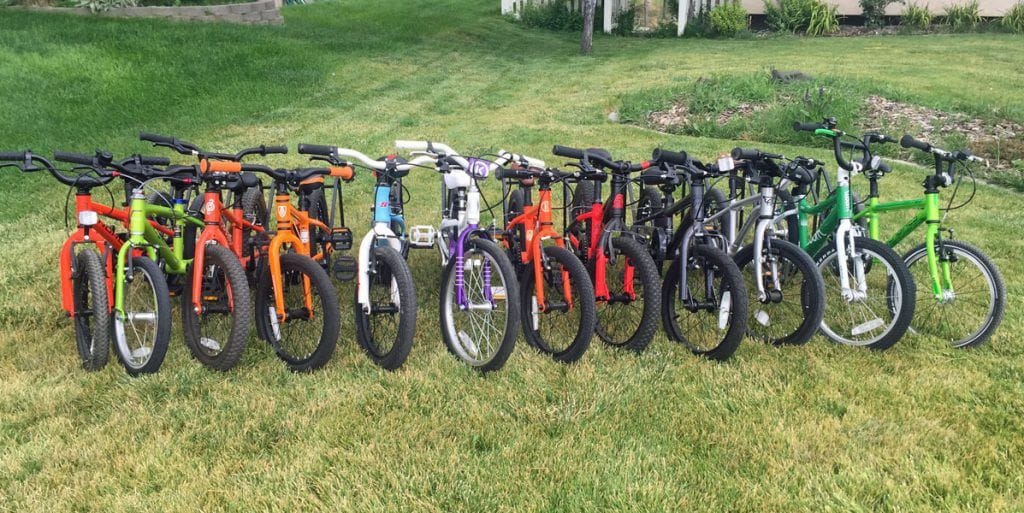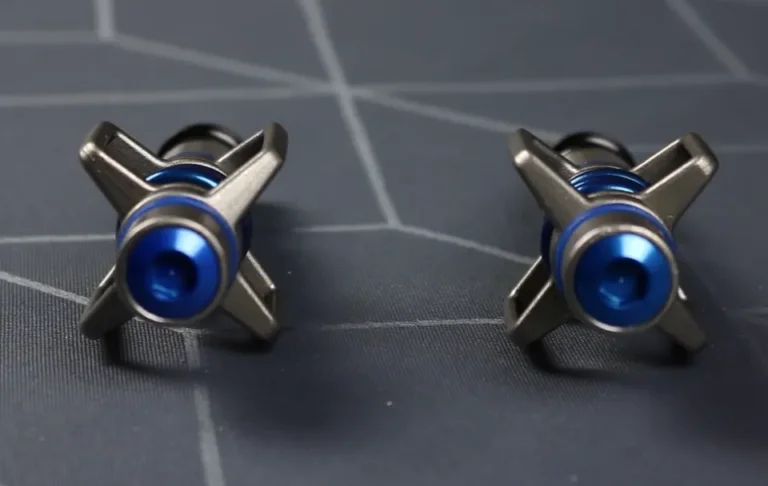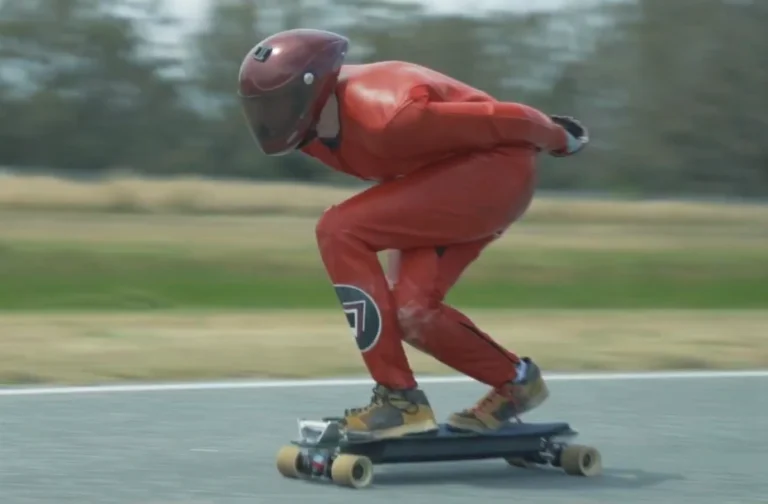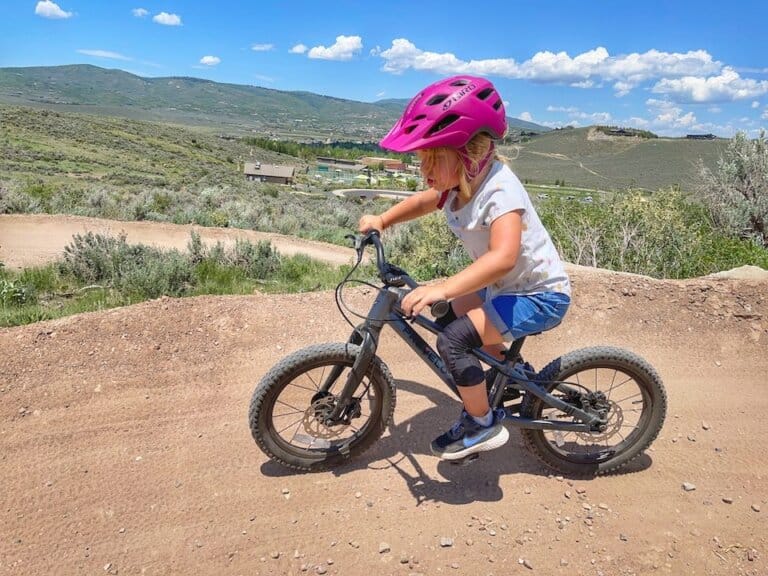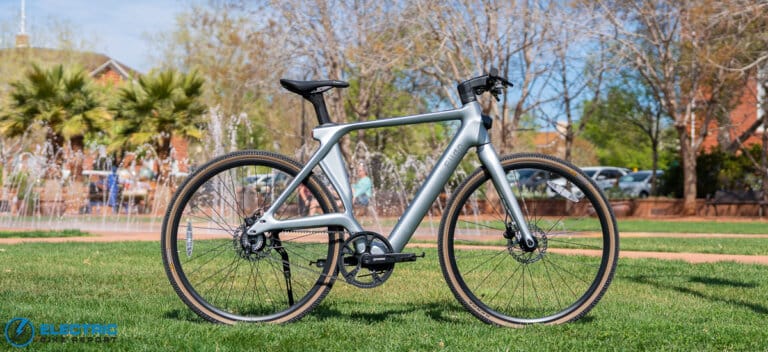We tested over 30 bikes!

When it comes to 16-inch bikes, they’re often a child’s first taste of true independent riding, making the perfect fit essential for both comfort and safety. But with such a wide range of sizes among bikes, it can be tricky to nail down the perfect one without a bit of guidance.
Why trust us? Over the last decade, we’ve tested over forty 16 inch pedal bikes with dozens of kids! Through hands-on experience, we’ve mastered the art of fitting your child to a bike (hint: it’s not just about wheel size!) and discovered which bike brands cater best to different types of riders.
While our top picks all have 16 inch wheels, check out our mini reviews below for a closer look at their actual size (or give our Kids Bike Finder Tool a try). Aim for a minimum seat height 0-2″ greater than your child’s inseam for the ideal fit. Check our kids bike sizes guide for further details.
Best 16 Inch Bikes for Kids
| Bike | Noteable Features | Price |
|---|---|---|
| Budget-friendly Bikes | ||
| Retrospec Koda | Classic design in fun colors* | $169 |
| Retrospec Koda Plus | Best Bang for Your Buck* | $249 |
| Guardian Bikes 16 | Innovative Sure Stop braking system | $249 |
| Neighborhood Bikes: Better for Mainly Paved Riding | ||
| Priority Start 16 | Sharp modern styling, quiet belt drive | $329 |
| Biky Air 16 | Light and nimble, lots of room for growth | $449 |
| Prevelo Alpha Two | Smallest 16″ bike, best for short riders | $469 |
| woom 3 | Fine tuned for beginning and timid riders | $479 |
| Multi-Use: Great for Paved and Dirt Trails | ||
| Pello Revo | Versatile fit for timid to dare devil riders | $399 |
| Early Rider Belter 16 | Impeccable build with aggressive geo, belt drive | $479 |
| * Bike has coaster brake (back pedal brake) | ||
BUDGET FRIENDLY 16 INCH BIKES
What We Look for in a Budget-Friendly Bike
While these bikes are not as high-end or as lightweight as the bikes that take our top recommendations, they all perform impressively for their price tag. They also feature good basic geometry with properly placed handlebars (not too high, not too low), a reasonable weight (under 21 lb.), and a durable build.
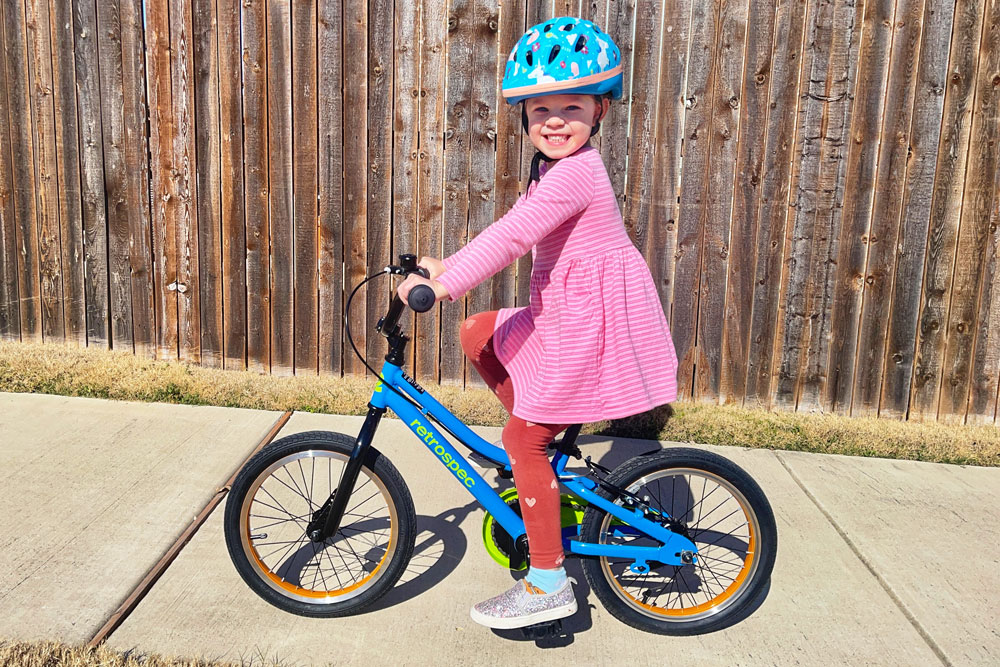
Retrospec Koda
$169
SEAT HEIGHT: 18.3″ – 23″
WEIGHT: 19.1 lb.
BRAKES: Rear hand brake, rear coaster brake
TRAINING WHEELS: Compatible and included
HIGHLIGHTS: Kid-friendly geometry for a comfortable, natural ride, great fit over time
Why We Love the Koda
Affordable bikes are often low quality and poorly designed, creating a frustrating riding experience for your child. But the Retrospec Koda is that rare gem of a kid’s bike that we are so excited to find. It’s super affordable, and also thoughtfully designed to be easy to ride! These types of bikes shouldn’t be rare gems, but unfortunately, they are.
While the Koda 16 bikes aren’t as fine-tuned or as lightweight as the more expensive budget bikes, their overall geometry and kid-friendly fit are pretty similar. If your budget is only under $150, we happily recommend these bikes.
What’s the difference between the Koda 16 and the Koda Plus 16? A few things, but the biggest is that the Plus model has dual hand brakes as well as a lightweight aluminum frame.

Retrospec Koda Plus
$249
SEAT HEIGHT: 19″ – 24″
WEIGHT: 17.7 lb.
BRAKES: Front and rear hand brake, rear coaster
TRAINING WHEELS: Compatible and included
HIGHLIGHTS: Great quality and performance, comfortable saddle, comes with training wheels
Why We Love the Koda Plus
The Retrospec Koda Plus offers a lightweight aluminum frame, child-friendly geometry, and easy-to-use, adjustable hand brakes—making it a standout choice in its price range. If you’re looking for a durable bike that can last for years and be passed down through multiple kids, without spending a fortune, the Koda Plus is a solid option.
Compared to the standard Koda, the Koda Plus upgrades the frame from steel to aluminum and adds dual hand brakes (versus the Koda’s single rear hand brake). Both bikes are very similar in size and geometry, but the Koda Plus delivers a lighter, more responsive ride with better braking control.
It’s also a great pick if you plan to use training wheels, as it comes with them included and is fully compatible. While bikes like the Guardian are also training-wheel compatible, they don’t include them by default and require an extra purchase. The Koda Plus does have a coaster brake, unlike the Guardian, but for those starting out with training wheels, that’s often less of a concern.

Guardian Bikes 16
$249
SEAT HEIGHT: 18.25″ – 22.6″
WEIGHT: 17.5 lb.
BRAKES: Unique SureStop hand brake system
TRAINING WHEELS: Compatible, but not included
HIGHLIGHTS: Proprietary braking system helps kids stop bike with more control
What We Love About the Guardian
While Guardian bikes boast lightweight frames and a kid-specific design for a good price, what really makes Guardian stand out is their proprietary braking system called SureStop.
Designed to prevent unsafe braking, SureStop has only one brake lever that sequentially engages the rear and front brakes. Not only it is the safest system on the market, but it’s also much easier to use than most traditional dual-hand brakes.
When braking with just the front hand brake while at high speeds, bikes can tilt forward, bucking the child off the bike and over the handlebars. SureStop on Guardian bikes prevents this by having only one brake lever engage the front and rear brakes.
What this also means is that the Guardian 16 does not have a coaster brake (back pedal brake). This is the most affordable 16″ bike without a coaster brake. Why does this matter? Coaster brakes actually make it much harder for kids to learn to ride.
BEST FOR NEIGHBORHOOD RIDERS
What We Look for in a Neighborhood Bike
Most kids on 16 inch bikes stick to riding around the neighborhood. Stable and lightweight, high-quality neighborhood bikes should also be be easy to ride, easy to balance, and perform consistently. Dual hand brakes and NO coaster brake are also a requirement to make our list.
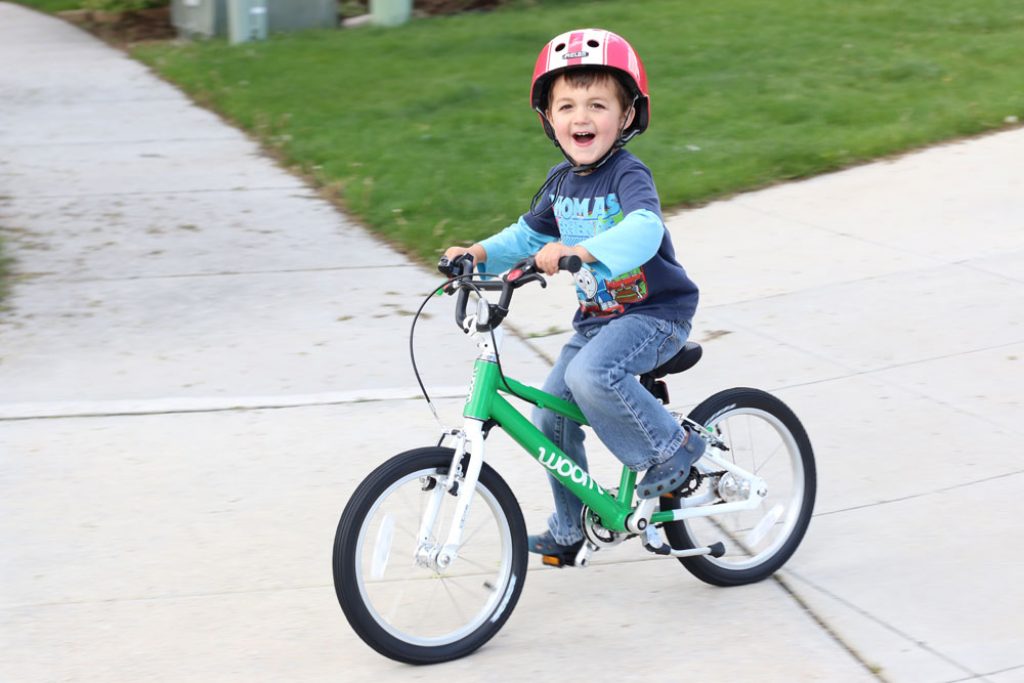
woom 3
$479 for single speed, $529 for Automagic
SEAT HEIGHT: 19.1″ – 25.2″
WEIGHT: 13.1 lb., or 14.6 lb. for Automagic
BRAKES: Dual hand brakes, no coaster
TRAINING WHEELS: Not compatible
HIGHLIGHTS: Comfortable, upright geometry, super lightweight
What We Love About the woom 3
The go-to bike for beginning riders. woom Bikes is a high-end, child-specific bike company that takes pride in designing bikes built specifically for children’s smaller frames. Smaller, lighter, and with a lower center-of-gravity than the average bike, the woom 3 is incredibly easy to balance and has a special brake system to help little newbies learn to properly use dual hand brakes for the first time.
Of all the bikes on this list, the woom 3 is the easiest bike to learn to ride on for true beginners. If you think your child will develop into a confident speed demon, the woom 3 AUTOMAGIC is offered with a 2-speed rear hub that automatically shifts a child into a higher gear when needed.
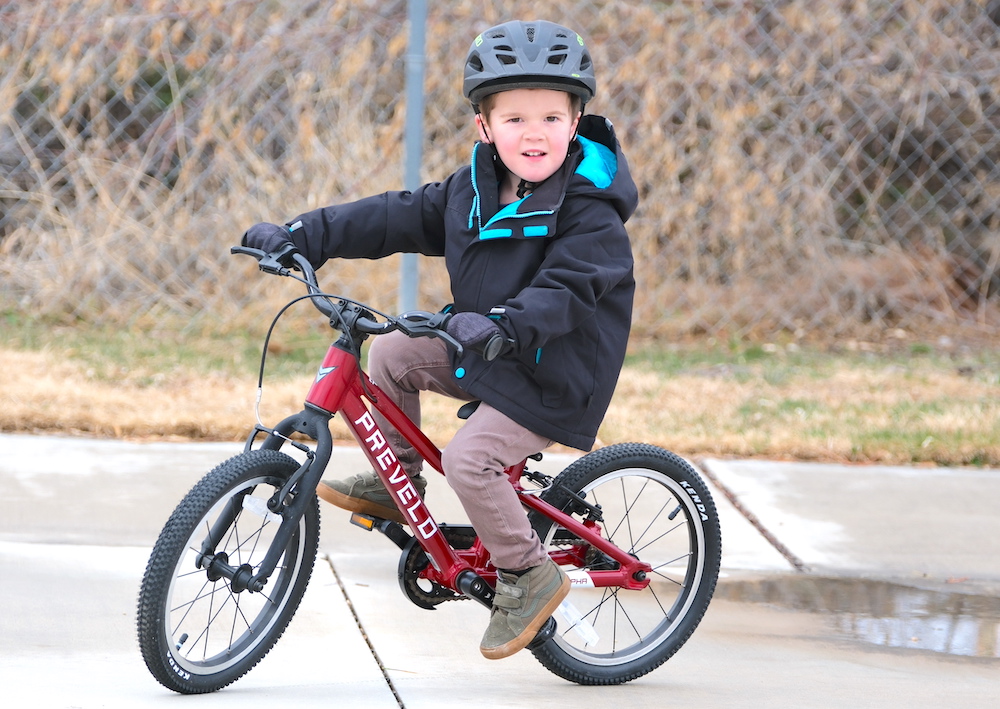
Prevelo Alpha Two
$469
SEAT HEIGHT: 17″ – 25″
WEIGHT: 14.4 lb.
BRAKES: Dual hand brakes
TRAINING WHEELS: Not compatible
HIGHLIGHTS: Frame hugger saddle allows for a super low minimum seat height
What We Love About the Prevelo Alpha Two
Engineered for kids with a lightweight frame and higher gearing, the Prevelo Alpha Two is a great option for kids who want to enjoy a long ride with the family. With a 3.8 gain ratio, the rider gains considerable distance with each pedal stroke, making long rides easier for young riders.
But what really sets the Alpha Two apart is its super low minimum seat height of 17″. As the smallest 16″ bike that we know of, this Prevelo is uniquely sized to allow younger riders to reap the benefits of larger 16″ wheels at a younger age.
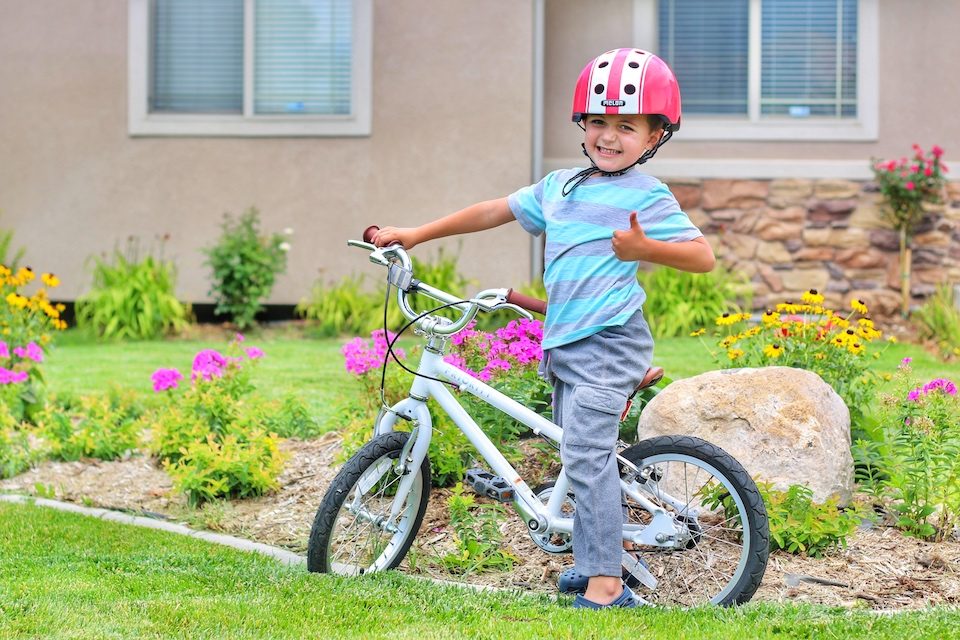
Priority Start 16
$329
SEAT HEIGHT: 18.5″ – 23″
WEIGHT: 15.9 lb.
BRAKES: Dual hand brakes
TRAINING WHEELS: Compatible, but not included
HIGHLIGHTS: Grease-free low maintenance belt drive (no chain)
Why We Love the Priority Start
Built with high-end components that provide durability and performance, the Priority 16 packs a lot of punch in its price tag. Priority Bicycles got their start with Kickstarter and has grown into a well-respected, innovative bike brand.
A great first “real” kids bike with more sophisticated adult styling, the Start will have your child craving adventure on two wheels in no time. But what makes Priority Bicycles different from all the rest? The Gates carbon belt drive, which replaces a traditional bike chain.
Kids think the super quiet belt drive is ninja cool for stealth mode, and parents love that the belt drive requires basically no maintenance, and won’t get hands or pants greasy.

BIKY AIR 16
$399
SEAT HEIGHT: 17.5″ – 25″
WEIGHT: 12.5 lb.
BRAKES: Dual hand brakes
TRAINING WHEELS: Not compatible
HIGHLIGHTS: Superlight weight, comfortable semi-upright body position
Why We Love the BIKY AIR
In addition to being one of the lightest 16″ bikes on the market, the BIKY AIR 16 also offers an impressive fit range. With a low minimum seat height of 17.5″ and a maximum height of 25″, the Biky stands out for its versatility, accommodating a wide range of riders.
The Biky’s mid-rise handlebars strike a perfect balance—they aren’t too high for the smallest riders, avoiding an awkward high-rise position; they aren’t too low for taller riders, ensuring comfort without forcing an overly aggressive posture. This makes them a perfect Goldilocks height.
One drawback of the Biky 16 is its single handbrake on the rear wheel. While our testers had no trouble safely stopping the bike, adventurous speed demons might prefer a bike equipped with dual-hand brakes for increased stopping power.
BIKES FOR ADVENTUROUS RIDERS
What We Look for in a Bike for Adventurous Riders
Riders ready to hit the trails—whether paved or compact dirt—and tackle every ramp or curb will benefit from low-rise handlebars that place the body in a more forward-leaning position.
This allows riders to easily shift their weight to maintain balance on uneven surfaces, ramps, curbs, etc. Wider and knobbier tires, as well as dual-hand brakes and no coaster brake, also help little adventurers to maneuver safely through more technical terrain.
If you’re raising a little shredder and are looking for a dedicated 16 inch mountain bike, be sure to check out our favorite 16″ bikes for single track.
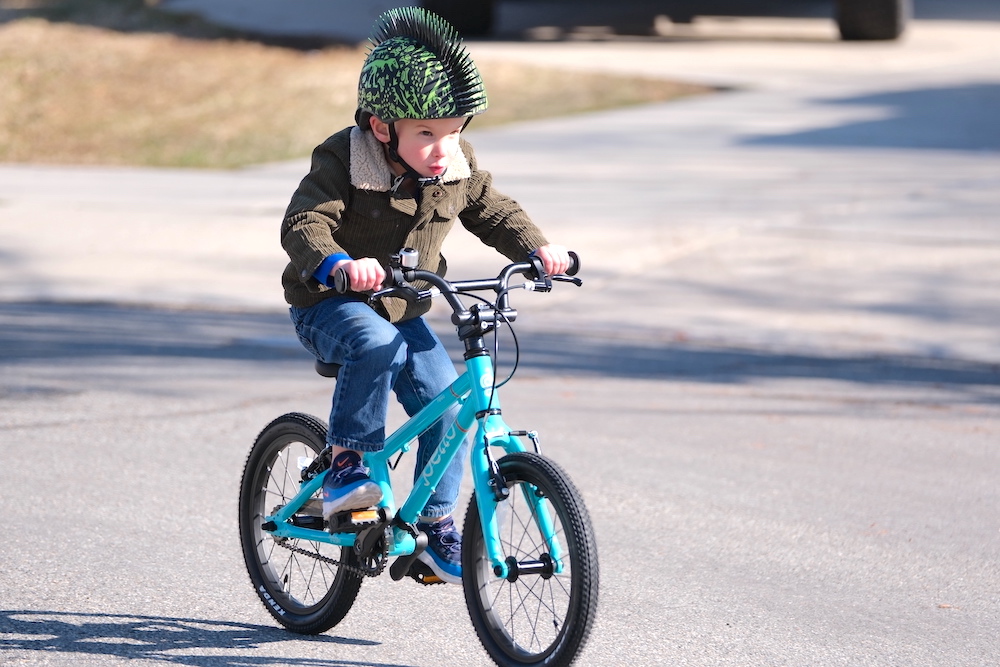
Pello Revo
$399
SEAT HEIGHT: 19″ – 24.5″
WEIGHT: 14.6 lb.
BRAKES: Dual hand brakes
TRAINING WHEELS: Not compatible
HIGHLIGHTS: Lightweight build, adjustable handlebars, knobby tires, high-end components
What We Love About the Pello
Whether your little one is timid to get started on a bike or is ready to charge full on into the world via two wheels, the Pello Revo is ready for action. With a lightweight build, quality brakes that stop on a dime, and handlebars that adjust to fine tune the fit, the Revo provides a comfortable, exciting, and nimble ride.
Built with a semi-upright geometry, the Revo positions the rider upright enough to help timid riders feel comfortable. With the ability to tilt the handlebars closer or farther away from the rider, the Revo can easily be customized to your rider’s preferred fit.
If your neighborhood rider decides to get aggressive and take their love of riding off-road, the Revo’s all-terrain tires are ready for the job! If they happen to fall in love with the dirt, the Revo is also compatible with up to 2.1″ wide tires (1.5″ is standard).

Early Rider Belter 16
$479
SEAT HEIGHT: 19.5″ – 23.5″
WEIGHT: 13.7 lb.
BRAKES: Dual hand brakes
TRAINING WHEELS: Not compatible
HIGHLIGHTS: Super smooth, grease-free belt drive; amazing quality; aggressive geo
What We Love About the Early Rider Belter
If the showstopping build and aesthetics of the Early Rider Belter don’t draw you in, its performance certainly will! Built with a grease-free belt drive instead of a traditional bike chain, the Belter rides exceptionally smoothly and, as an added perk, requires very little maintenance.
The Belter’s aggressive geometry makes it ideal for city riders eager to tackle every curb, ramp, or jump they encounter. The bike’s low-rise handlebar allows riders to easily lean into the bike and shift their weight when getting adventurous.
For a little extra cushioning through the city jungles, the Belter comes with 2.0″ wide tires with a smooth street tread. If dirt trails or single track are in your little rider’s future, the Early Rider Seeker 16 model offers the same build as the Belter but with knobby tires for better off-road performance.
However, due to the Belter’s lack of a chain guard (or belt guard), take caution to ensure your little rider isn’t wearing baggy clothes (such as pants, skirts, or dresses) while on the Belter – they could get caught in the belt. While we haven’t experienced this issue with the new Belter 16, it was a problem with their older model.
OTHER 16 INCH BIKES TO CONSIDER
Not every bike we test can make our Top 10, but here are a few honorable mention bikes you should also consider.
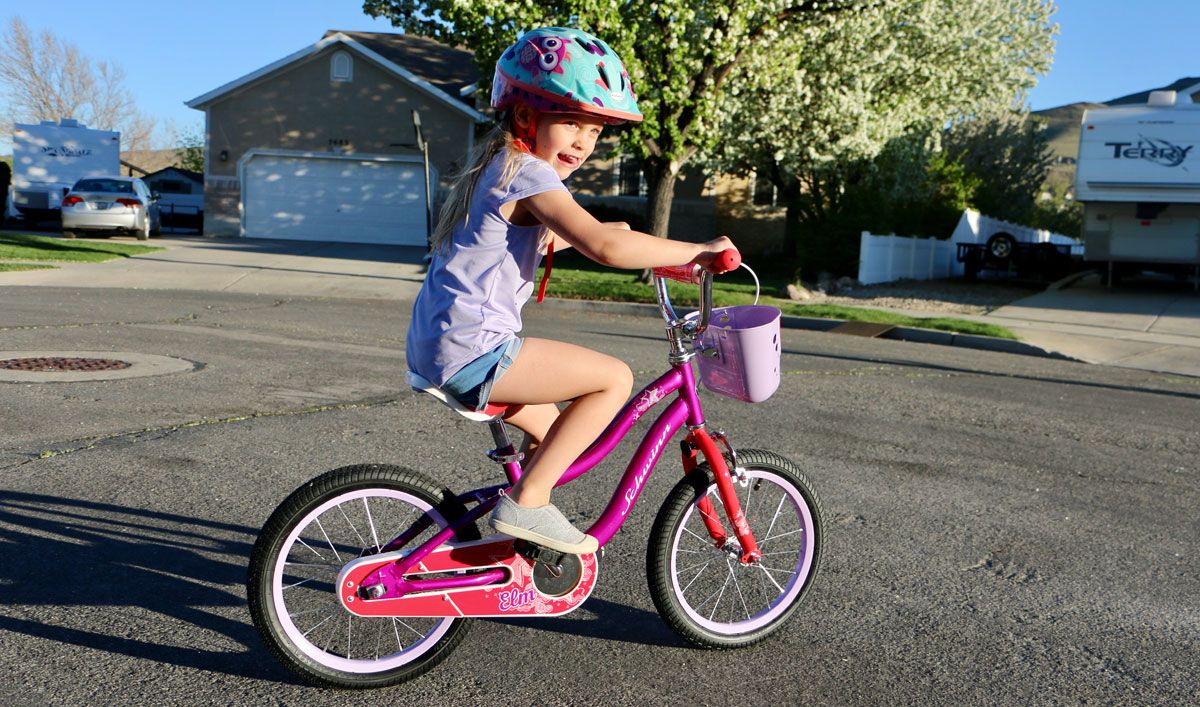
Schwinn Koan/Elm
$189
SEAT HEIGHT: 20.5″ – 24.5″
WEIGHT: 20.6 lb.
BRAKES: Front hand brake, rear coaster brake
TRAINING WHEELS: Compatible and included
HIGHLIGHTS: Good value, cute designs, compatible with Flex Guiders learning training wheels
What to Know about the Schwinn
Available in multiple styles and from multiple retailers, Schwinn’s SmartStart Series collection of bikes (which includes the Elm 16 inch girls bike and Koen 16 inch boys bike) are a big step up from cheap big-box store bikes. Lighter than those bikes, the SmartStart Series also provides a better, child-specific geometry which allows for a more stable and comfortable ride for kids.
While the overall design is still a lower-quality, budget build, the price tag is much more affordable for many parents. The SmartStart Series does come with a handbrake, but it’s poorly made and riders will have to rely on the coaster brake to stop.
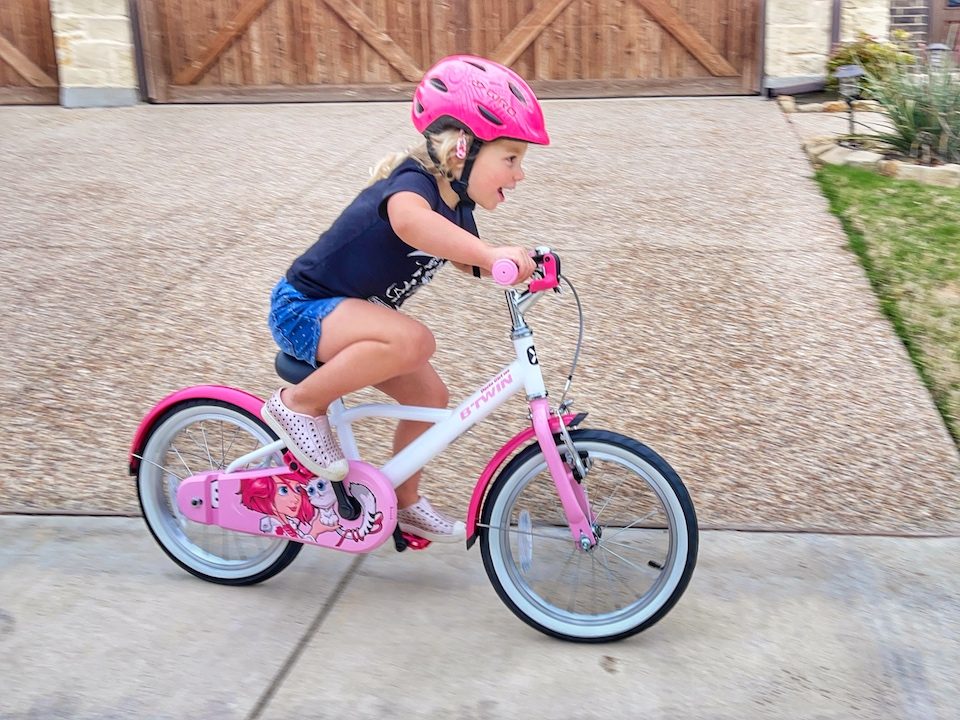
Decathlon Btwin
$99+
SEAT HEIGHT: 19.5″ – 23.75″
WEIGHT: 20.6 lb. (model with kickstand and fenders)
BRAKES: Front hand brake, rear coaster
TRAINING WHEELS: Not included, not compatible
HIGHLIGHTS: Kid-friendly geometry with good basic components, innovative front hand brake
What We Love About the Btwin
**These models have been discontinued in the US by Decathlon, so stock is limited.**
Impressively well-designed for the price, the Btwin 100 and 500 16 inch boys and girls bikes provide a smooth, comfortable ride. With slightly lower-rise handlebars, they perform better for adventurous kids who are likely to lean in for speed or to go over small jumps or curbs, while also being perfect for neighborhood cruising.
More lightweight than other low-price kids’ bikes, Btwin kids’ bikes offer the best quality for the price. If you’re on a tight budget, it doesn’t get better than Btwin. While more expensive, the Btwin bikes are easier to ride and are better quality than the popular Schwinn Elm or Koen.
How to Choose the Best 16 inch Bike
While we have a much more detailed discussion about what makes a great bike in our best kids’ bikes buying guide, here’s a quick summary of the most important things to look for to find the perfect bike for your 4 or 5-year-old.
Size – 16 inch bikes vary widely
A 16 inch bike is generally the best fit to purchase for 4 and 5-year-olds. If your child is a very tall 5-year-old, a 20 inch bike should also be considered to allow for more room for growth.
Within the 16 inch wheel size, there is a very large range of seat heights. The smallest 16 inch bike we recommend has a 17″ minimum seat height, while another has a minimum seat height of 21.5″! To allow for the most room for growth, find a bike that has a minimum seat height that comes as close as possible to your child’s ideal seat setting (which will vary based on inseam and whether or not this is your child’s first pedal bike).
If this bike is your child’s first pedal bike after a balance bike, the bike’s seat should be set at or just below their inseam measurement. This allows a child to sit on the seat and easily put their feet down to steady themselves or stop the bike. This is critical as they learn to pedal to instill confidence, and for maximum safety.
If your child has already mastered pedaling, you should set the bike’s seat about 2″ above the child’s inseam to allow for maximum efficiency while pedaling.
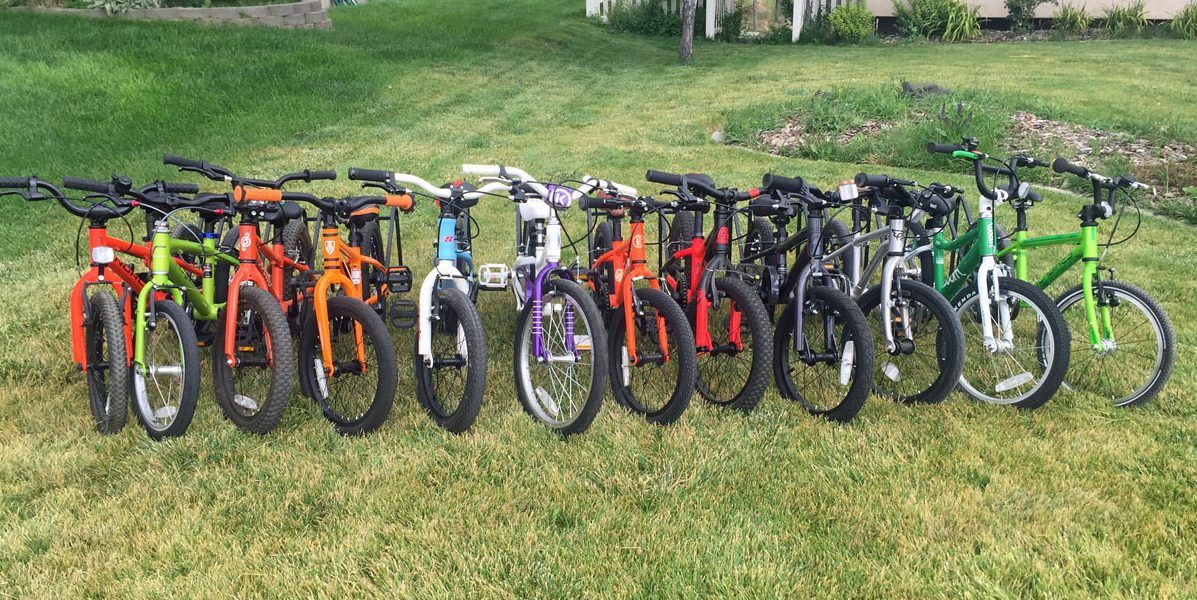
Weight – Lightweight is key to gaining confidence
Ideally, your child’s bike shouldn’t weigh more than 30% of their body weight. In general, the lighter the bike, the easier and less tiring it will be for your child to ride. Heavy bikes are really hard to manage for little ones who are still mastering the art of balancing and pedaling at the same time!
For example, can you imagine a 4-year-old trying to ride the Royal Baby 16″ bike which weighs 24 pounds compared to the woom 3 at 13.1 pounds?? Since kids are often starting off their pedal bike journey on a 16″ bike, when possible, we often encourage parents to step up their budget a bit in order to get their kids on a lighter weight bike. With a lightweight bike they can quickly become confident little pedalers. Once confident, they can often tackle a heavier, often lesser quality bike for their next bike.
Frame Design – It goes way beyond looks!
A bike’s frame design plays a major role in the overall feel and performance of a bike. Some bikes put a child in an upright position that feels very natural for beginning riders and is great for neighborhood riding.
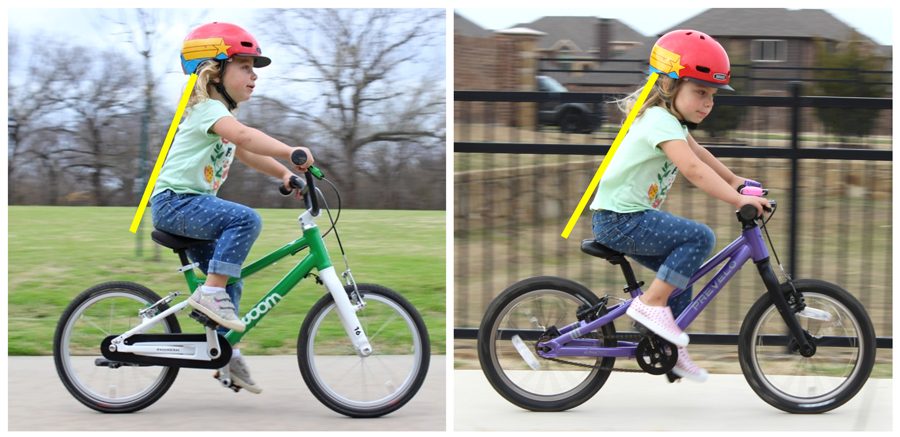
Other bikes require a rider to lean forward to grip the handlebars, putting kids in a more aggressive position. These types of bikes are generally better for more experienced, adventurous riders who will be doing more aggressive riding.
Big-box store and budget bikes sold online often have poorly designed frames that make them difficult to ride. While they meet basic CPSC safety standards, these bikes are typically mass-produced with little attention to geometry or performance, resulting in a frustrating riding experience. Whenever possible, opt for a well-designed bike that offers better control, comfort, and durability.
Brakes – Try to avoid coaster brakes
Coaster brakes (back pedal brakes) are often found on 16 inch bikes, but they can inhibit a child’s ability to learn to pedal while balancing a bike. Why?
When learning to pedal and balance on a bike, kids (like adults!) naturally pedal backward when attempting to regain their balance. If the bike has a coaster brake, pedaling backward inadvertently activates the bike’s brake, which slows the bike and often leads to a crash. Without a coaster brake, pedaling backward to regain balance isn’t a problem.

As a result, we much prefer bikes without coaster brakes and with responsive hand brakes that are easy for small hands to operate.
Gearing – How fast will the bike go?
For kids ages 4, 5, and 6, gears are just too much to handle and bikes with gears and shifters are not available on 16 inch bikes. However, the gearing of a bike is still worth taking into consideration. In the biking world, the gain ratio relates to the gearing of a single-speed bike and is often used to determine how hard it is to pedal a bike.
High gain ratios (3.7+) are harder to get started pedaling but can more easily maintain higher speeds. Lower gain ratios (3.3 and below) are really easy to start pedaling but can’t reach high maximum speeds. Gain ratios in the middle do a little bit of both! For 16 inch bikes, we generally prefer mid-range gain ratios from about 3.5 to 3.8.
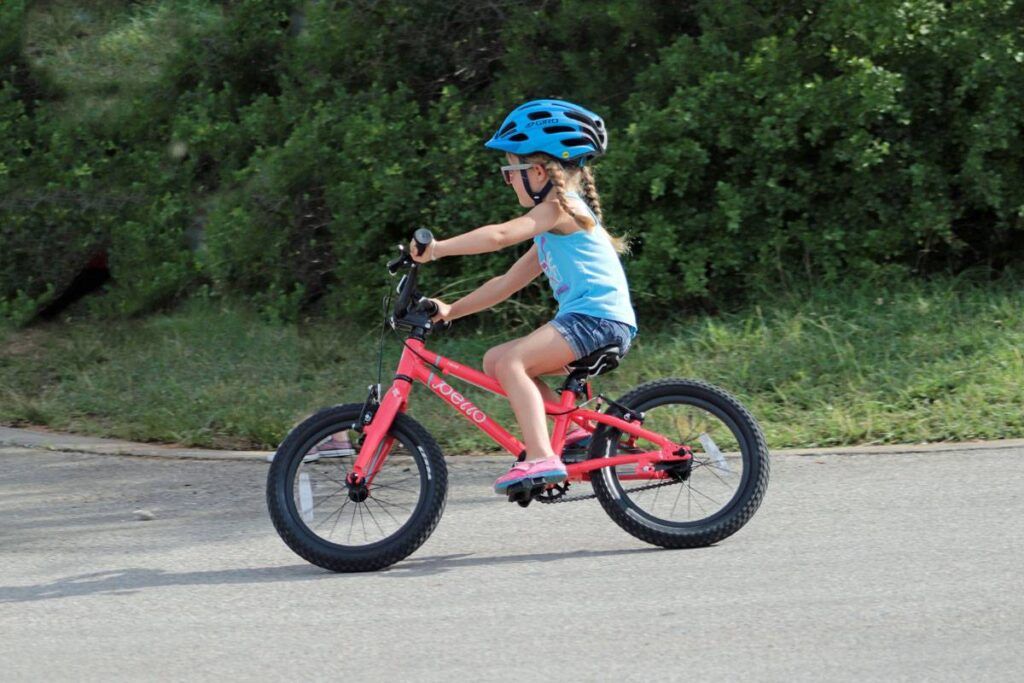
Price – What does a more expensive bike get me?
Good bikes are not cheap. Every bike on this list is significantly better than a bike you’ll find at Walmart, but also costs more. Why? It’s not easy making a high-quality, lightweight bike! There is a reason some adults bikes cost more than a car.
In the end, after testing over 50 different 16 inch bikes, we can confidently say that higher-end bikes are MUCH easier for kids to ride than budget bikes found at big-box stores.
While any bike (well, any safe bike) is better than no bike, if you want your child to start their biking journey off with a smile versus tears and frustration, we highly recommend splurging on a nicer bike when possible. Higher-end bikes also typically have great resale values, with many re-selling for close to 70% of their MSRP.
Girls vs Boys Bikes
Is there really any difference between girls bike or boys bikes? Beyond color or design patterns, not really. There are a few cheaper girls bikes that have swooping frames, but in today’s world, all of the best kids bikes have identical frames and components for boys and girls.
All kids bike brands offer a range of colors from “girly” to “boyish” or gender neutral. You don’t need to look for a “girl” or “boy” bike, just choose the best kids bike, and find a color your child loves. If you’re wondering which brands have purple and pink and turquoise colors for a 4 or 5 year old girl, check out our page on the best bikes for girls.
You also always have the option of adding cute bike accessories to any bike to make it more feminine. For our favorite girls bike accessories, check out our list of best kids bike accessories.
Related Kids 16 Inch Bikes Articles
Training Wheels: 10 Frequently Asked Questions: If you’re considering training wheels, read this first!
How to Teach a Child to Ride a Bike – It doesn’t have to be painful!
10 Best Girl Bikes: Looking for a high-performance bike in pink, purple, or cute designs? Check out our list!

